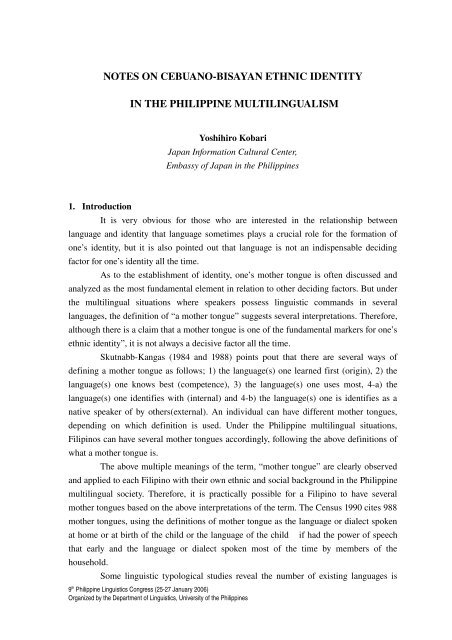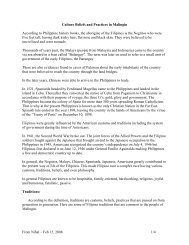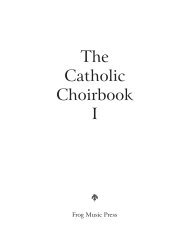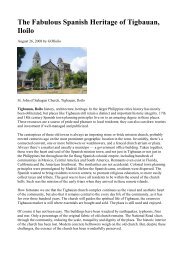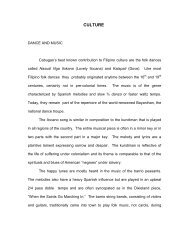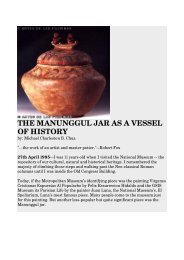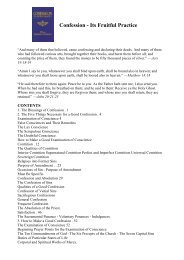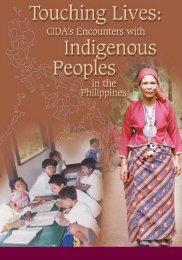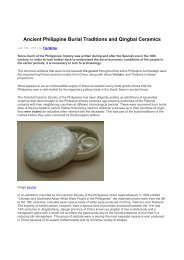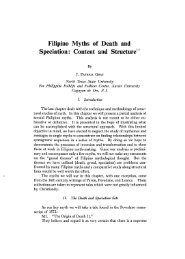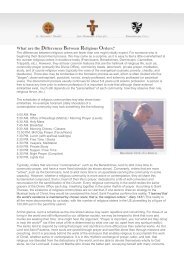Notes on Cebuano-Bisayan Ethnic Identity in the ... - AboutPhilippines
Notes on Cebuano-Bisayan Ethnic Identity in the ... - AboutPhilippines
Notes on Cebuano-Bisayan Ethnic Identity in the ... - AboutPhilippines
You also want an ePaper? Increase the reach of your titles
YUMPU automatically turns print PDFs into web optimized ePapers that Google loves.
NOTES ON CEBUANOBISAYAN ETHNIC IDENTITY<br />
IN THE PHILIPPINE MULTILINGUALISM<br />
Yoshihiro Kobari<br />
Japan Informati<strong>on</strong> Cultural Center,<br />
Embassy of Japan <strong>in</strong> <strong>the</strong> Philipp<strong>in</strong>es<br />
1. Introducti<strong>on</strong><br />
It is very obvious for those who are <strong>in</strong>terested <strong>in</strong> <strong>the</strong> relati<strong>on</strong>ship between<br />
language and identity that language sometimes plays a crucial role for <strong>the</strong> formati<strong>on</strong> of<br />
<strong>on</strong>e’s identity, but it is also po<strong>in</strong>ted out that language is not an <strong>in</strong>dispensable decid<strong>in</strong>g<br />
factor for <strong>on</strong>e’s identity all <strong>the</strong> time.<br />
As to <strong>the</strong> establishment of identity, <strong>on</strong>e’s mo<strong>the</strong>r t<strong>on</strong>gue is often discussed and<br />
analyzed as <strong>the</strong> most fundamental element <strong>in</strong> relati<strong>on</strong> to o<strong>the</strong>r decid<strong>in</strong>g factors. But under<br />
<strong>the</strong> multil<strong>in</strong>gual situati<strong>on</strong>s where speakers possess l<strong>in</strong>guistic commands <strong>in</strong> several<br />
languages, <strong>the</strong> def<strong>in</strong>iti<strong>on</strong> of “a mo<strong>the</strong>r t<strong>on</strong>gue” suggests several <strong>in</strong>terpretati<strong>on</strong>s. Therefore,<br />
although <strong>the</strong>re is a claim that a mo<strong>the</strong>r t<strong>on</strong>gue is <strong>on</strong>e of <strong>the</strong> fundamental markers for <strong>on</strong>e’s<br />
ethnic identity”, it is not always a decisive factor all <strong>the</strong> time.<br />
SkutnabbKangas (1984 and 1988) po<strong>in</strong>ts pout that <strong>the</strong>re are several ways of<br />
def<strong>in</strong><strong>in</strong>g a mo<strong>the</strong>r t<strong>on</strong>gue as follows; 1) <strong>the</strong> language(s) <strong>on</strong>e learned first (orig<strong>in</strong>), 2) <strong>the</strong><br />
language(s) <strong>on</strong>e knows best (competence), 3) <strong>the</strong> language(s) <strong>on</strong>e uses most, 4a) <strong>the</strong><br />
language(s) <strong>on</strong>e identifies with (<strong>in</strong>ternal) and 4b) <strong>the</strong> language(s) <strong>on</strong>e is identifies as a<br />
native speaker of by o<strong>the</strong>rs(external). An <strong>in</strong>dividual can have different mo<strong>the</strong>r t<strong>on</strong>gues,<br />
depend<strong>in</strong>g <strong>on</strong> which def<strong>in</strong>iti<strong>on</strong> is used. Under <strong>the</strong> Philipp<strong>in</strong>e multil<strong>in</strong>gual situati<strong>on</strong>s,<br />
Filip<strong>in</strong>os can have several mo<strong>the</strong>r t<strong>on</strong>gues accord<strong>in</strong>gly, follow<strong>in</strong>g <strong>the</strong> above def<strong>in</strong>iti<strong>on</strong>s of<br />
what a mo<strong>the</strong>r t<strong>on</strong>gue is.<br />
The above multiple mean<strong>in</strong>gs of <strong>the</strong> term, “mo<strong>the</strong>r t<strong>on</strong>gue” are clearly observed<br />
and applied to each Filip<strong>in</strong>o with <strong>the</strong>ir own ethnic and social background <strong>in</strong> <strong>the</strong> Philipp<strong>in</strong>e<br />
multil<strong>in</strong>gual society. Therefore, it is practically possible for a Filip<strong>in</strong>o to have several<br />
mo<strong>the</strong>r t<strong>on</strong>gues based <strong>on</strong> <strong>the</strong> above <strong>in</strong>terpretati<strong>on</strong>s of <strong>the</strong> term. The Census 1990 cites 988<br />
mo<strong>the</strong>r t<strong>on</strong>gues, us<strong>in</strong>g <strong>the</strong> def<strong>in</strong>iti<strong>on</strong>s of mo<strong>the</strong>r t<strong>on</strong>gue as <strong>the</strong> language or dialect spoken<br />
at home or at birth of <strong>the</strong> child or <strong>the</strong> language of <strong>the</strong> child<br />
if had <strong>the</strong> power of speech<br />
that early and <strong>the</strong> language or dialect spoken most of <strong>the</strong> time by members of <strong>the</strong><br />
household.<br />
Some l<strong>in</strong>guistic typological studies reveal <strong>the</strong> number of exist<strong>in</strong>g languages is<br />
9 th Philipp<strong>in</strong>e L<strong>in</strong>guistics C<strong>on</strong>gress (2527 January 2006)<br />
Organized by <strong>the</strong> Department of L<strong>in</strong>guistics, University of <strong>the</strong> Philipp<strong>in</strong>es
Kobari/<str<strong>on</strong>g>Notes</str<strong>on</strong>g> <strong>on</strong> <strong>Cebuano</strong><strong>Bisayan</strong> <strong>Ethnic</strong> Indentity<br />
120 (it is estimated that <strong>the</strong>re exist more than Philipp<strong>in</strong>e languages and dialects). This<br />
<strong>in</strong>dicates <strong>the</strong> fact that <strong>the</strong> number of Philipp<strong>in</strong>e languages identified by Filip<strong>in</strong>o<br />
resp<strong>on</strong>dents <strong>in</strong> The 1990 Census greatly exceeded <strong>the</strong> number revealed by l<strong>in</strong>guists <strong>on</strong><br />
Philipp<strong>in</strong>e languages. The ethnic name for a group does not always corresp<strong>on</strong>d to <strong>the</strong><br />
name of <strong>the</strong>ir language and <strong>the</strong> same language based <strong>on</strong> <strong>the</strong> l<strong>in</strong>guistic <strong>in</strong>quiry can have<br />
several different names accord<strong>in</strong>g to <strong>the</strong> o<strong>the</strong>r ethnic ic<strong>on</strong>s of <strong>the</strong>ir group. Thus, <strong>the</strong>re<br />
exists a comm<strong>on</strong>ly used term, an ethnol<strong>in</strong>guistic community, <strong>the</strong> relati<strong>on</strong> between an<br />
ethnic group and <strong>the</strong>ir language is not straightforward as we usually experience <strong>in</strong><br />
l<strong>in</strong>guistic fieldwork.<br />
In additi<strong>on</strong> to <strong>the</strong> differences <strong>in</strong> <strong>the</strong> names of an ethnic group and <strong>the</strong>ir language,<br />
<strong>the</strong>se different names c<strong>on</strong>note various noti<strong>on</strong>s of an ethnic identity c<strong>on</strong>structed arbitrarily<br />
<strong>in</strong> a wider local, regi<strong>on</strong>al (sometimes nati<strong>on</strong>al and <strong>in</strong>ternati<strong>on</strong>al) c<strong>on</strong>text. First of all, a<br />
sense of bel<strong>on</strong>g<strong>in</strong>gness to a certa<strong>in</strong> ethnic group is fundamentally realized by <strong>the</strong><br />
outsiders who do not share “similarities” am<strong>on</strong>g <strong>the</strong> members of <strong>the</strong> group <strong>in</strong> <strong>the</strong>ir<br />
locality or <strong>in</strong> some cases, a wider comprehensive community such as <strong>the</strong> nati<strong>on</strong> def<strong>in</strong>es<br />
boundaries am<strong>on</strong>g different groups. The process of build<strong>in</strong>g selfawareness requires<br />
objective judgments by o<strong>the</strong>rs and <strong>on</strong>ce <strong>the</strong> existence of <strong>the</strong>se objective judgments is<br />
recognized am<strong>on</strong>g people, a name is given to grant its existence. Through this process, <strong>the</strong><br />
awareness for “we”“o<strong>the</strong>rs” dichotomy is built. Then, this process requires names for<br />
differentiati<strong>on</strong> and <strong>the</strong>se differences come to be c<strong>on</strong>ceived as well as perceived with<br />
ethnic ideological implicati<strong>on</strong>s <strong>in</strong> c<strong>on</strong>texts. This process of selfawareness is complex <strong>in</strong><br />
multil<strong>in</strong>gual c<strong>on</strong>texts where multil<strong>in</strong>gual <strong>in</strong>dividuals use several languages simultaneously<br />
to meet <strong>the</strong>ir communicative needs. The relati<strong>on</strong>ship of “we”“o<strong>the</strong>rs” dichotomy is<br />
<strong>in</strong>tertw<strong>in</strong>ed and blurred <strong>in</strong> multil<strong>in</strong>gual discourses. On this po<strong>in</strong>t, as <strong>the</strong> def<strong>in</strong>iti<strong>on</strong> of a<br />
mo<strong>the</strong>r t<strong>on</strong>gue suggests, <strong>the</strong> relati<strong>on</strong>ship between an ethnic identity and a multil<strong>in</strong>gual<br />
speaker can be <strong>in</strong>terpreted <strong>in</strong> several ways <strong>in</strong> relati<strong>on</strong> to his/her l<strong>in</strong>guistic abilities and<br />
language use. Therefore, <strong>the</strong> multiplicity of <strong>on</strong>e’s identity <strong>in</strong> relati<strong>on</strong> to language(s) can be<br />
obviously observed.<br />
Based <strong>on</strong> <strong>the</strong> po<strong>in</strong>ts cited above, I would like to exam<strong>in</strong>e <strong>the</strong> relati<strong>on</strong>ship between<br />
<strong>on</strong>e’s language(s) and ethnic identity fur<strong>the</strong>r, tak<strong>in</strong>g <strong>the</strong> case of <strong>Cebuano</strong><strong>Bisayan</strong><br />
multil<strong>in</strong>gual speakers <strong>in</strong> <strong>the</strong> central and sou<strong>the</strong>rn multil<strong>in</strong>gual Philipp<strong>in</strong>e c<strong>on</strong>text.<br />
2. <strong>Ethnic</strong> <strong>Identity</strong> (Foundati<strong>on</strong> and Complexity of <strong>Ethnic</strong> Awareness)<br />
What factors decides an ethnic group? Off course, <strong>the</strong>re are numerous factors<br />
(such as l<strong>in</strong>guistic, cultural, ec<strong>on</strong>omic, and political factors) and <strong>the</strong>se factors have<br />
different roles with vary<strong>in</strong>g degrees of weight <strong>in</strong> decid<strong>in</strong>g what an ethnic group is and<br />
who <strong>the</strong> members are. How hard we try to expla<strong>in</strong> what an ethnic group is, it is always<br />
<strong>in</strong>adequate to get <strong>the</strong> comprehensive and explanatory view though we accumulate all <strong>the</strong><br />
9 th Philipp<strong>in</strong>e L<strong>in</strong>guistics C<strong>on</strong>gress (2527 January 2006)<br />
Organized by <strong>the</strong> Department of L<strong>in</strong>guistics, University of <strong>the</strong> Philipp<strong>in</strong>es<br />
2
Kobari/<str<strong>on</strong>g>Notes</str<strong>on</strong>g> <strong>on</strong> <strong>Cebuano</strong><strong>Bisayan</strong> <strong>Ethnic</strong> Indentity<br />
available ic<strong>on</strong>s for <strong>the</strong> group. Logically speak<strong>in</strong>g, it is a fundamental fact that <strong>on</strong>e could<br />
be a member of <strong>the</strong> ethnic group if he has a sense of bel<strong>on</strong>g<strong>in</strong>gness to a certa<strong>in</strong> ethnic<br />
community even with <strong>the</strong> lack of some recognized decid<strong>in</strong>g factors for <strong>the</strong> identificati<strong>on</strong><br />
of ethnic identity. Lev<strong>in</strong>s<strong>on</strong> (1998) briefly def<strong>in</strong>es <strong>the</strong> c<strong>on</strong>structi<strong>on</strong> of ethnic identity and<br />
<strong>the</strong> awareness of ethnic solidarity as follows;<br />
The basis of ethnic relati<strong>on</strong> is <strong>the</strong> presence of and <strong>in</strong>teracti<strong>on</strong> of members of<br />
different ethnic groups. <strong>Ethnic</strong> identity refers to <strong>the</strong> reality and <strong>the</strong> process<br />
through which people identify <strong>the</strong>mselves and are identified by o<strong>the</strong>rs as<br />
members of a specific ethnic group. <strong>Ethnic</strong> solidarity refers to <strong>the</strong> sense and<br />
degree of cohesi<strong>on</strong> felt by members of an ethnic group.<br />
The ethnic boundary is not felt when <strong>on</strong>e is with members of a certa<strong>in</strong> ethnic group which<br />
shares more similarities than differences. There are numerous physical and ideological<br />
factors (i.e. <strong>the</strong> color of sk<strong>in</strong>, <strong>the</strong> color of hair, customs, language, religi<strong>on</strong>, etc.) which<br />
serve as ic<strong>on</strong>s to differentiate <strong>on</strong>e from ano<strong>the</strong>r. These ic<strong>on</strong>s can be overtly and covertly<br />
recognized when people face each o<strong>the</strong>r, but physical as well as l<strong>in</strong>guistic features play as<br />
obvious symbols. When we engage <strong>in</strong> c<strong>on</strong>versati<strong>on</strong>s, we notice that <strong>on</strong>e has peculiar<br />
accents which we are not accustomed to <strong>in</strong> our everyday envir<strong>on</strong>ment. These l<strong>in</strong>guistic<br />
differences serve as markers for <strong>the</strong> separati<strong>on</strong> of ethnic groups and lead us to some<br />
ideological implicati<strong>on</strong>s beh<strong>in</strong>d <strong>the</strong>se ethnic differences. It is fundamentally described<br />
that language has two dist<strong>in</strong>ctive roles, communicative and symbolic functi<strong>on</strong>s. This<br />
symbolic perspective of language plays important roles <strong>in</strong> <strong>the</strong> formati<strong>on</strong> of ethnic identity<br />
with its arbitrary relati<strong>on</strong>ship between ethnic symbols and <strong>the</strong>ir c<strong>on</strong>notati<strong>on</strong>s <strong>in</strong> local<br />
c<strong>on</strong>texts.<br />
Then, this paper attempts to elaborate <strong>on</strong> <strong>the</strong> formati<strong>on</strong> of “we”“o<strong>the</strong>rs”<br />
dichotomy am<strong>on</strong>g people under Philipp<strong>in</strong>e historical, social, and cultural c<strong>on</strong>diti<strong>on</strong>s.<br />
3. The “We”“O<strong>the</strong>rs” Dichotomy <strong>in</strong> Philipp<strong>in</strong>e C<strong>on</strong>texts<br />
There are many books published <strong>on</strong> <strong>the</strong> Philipp<strong>in</strong>e history by lead<strong>in</strong>g scholars,<br />
but <strong>the</strong> brief summary of major Philipp<strong>in</strong>e historical events serves as a good guid<strong>in</strong>g hand<br />
to comprehend <strong>the</strong> flows of “we”“o<strong>the</strong>rs” awareness am<strong>on</strong>g Filip<strong>in</strong>os through history.<br />
The key terms, societal plurality and multiplicity are often used to describe comm<strong>on</strong><br />
features of Sou<strong>the</strong>ast Asian communities and <strong>the</strong>se terms depict <strong>the</strong> nature of Philipp<strong>in</strong>e<br />
society as well. Historically, local communities were bound with relatively loose ties and<br />
formed allies when necessary. Each local community fostered regi<strong>on</strong>al dist<strong>in</strong>ctiveness as<br />
observed and documented by friars, traders, travelers, col<strong>on</strong>ial bureaucrats, historians and<br />
o<strong>the</strong>rs. Accord<strong>in</strong>gly, <strong>the</strong> dist<strong>in</strong>cti<strong>on</strong> between “we” and “o<strong>the</strong>rs” was established with<strong>in</strong><br />
9 th Philipp<strong>in</strong>e L<strong>in</strong>guistics C<strong>on</strong>gress (2527 January 2006)<br />
Organized by <strong>the</strong> Department of L<strong>in</strong>guistics, University of <strong>the</strong> Philipp<strong>in</strong>es<br />
3
Kobari/<str<strong>on</strong>g>Notes</str<strong>on</strong>g> <strong>on</strong> <strong>Cebuano</strong><strong>Bisayan</strong> <strong>Ethnic</strong> Indentity<br />
<strong>the</strong>ir regi<strong>on</strong>al networks and ethnic differences were <strong>in</strong>terpreted <strong>in</strong> <strong>the</strong>ir locality. Then, <strong>the</strong><br />
country faced <strong>the</strong> periods of col<strong>on</strong>izati<strong>on</strong> by Spaniards, Americans, and Japanese for<br />
hundreds of years. F<strong>in</strong>ally <strong>the</strong> Philipp<strong>in</strong>es became <strong>in</strong>dependent after WWII with some<br />
sta<strong>in</strong>s of <strong>the</strong>se col<strong>on</strong>ial experiences <strong>in</strong> modern Philipp<strong>in</strong>e society.<br />
Under <strong>the</strong> societal structure of col<strong>on</strong>izati<strong>on</strong>, <strong>the</strong> bipolar relati<strong>on</strong>,<br />
“col<strong>on</strong>izer”“col<strong>on</strong>ized”, was c<strong>on</strong>structed am<strong>on</strong>g people’s c<strong>on</strong>sciousness with “we” as <strong>the</strong><br />
“col<strong>on</strong>ized” and “o<strong>the</strong>rs” as <strong>the</strong> “col<strong>on</strong>izer”.<br />
With <strong>the</strong> growth of a nati<strong>on</strong>al<br />
c<strong>on</strong>sciousness, <strong>the</strong> term, Filip<strong>in</strong>o 1 , ga<strong>in</strong>ed <strong>the</strong> recogniti<strong>on</strong> of what it means today. As to<br />
<strong>the</strong> process of collecti<strong>on</strong> of ethnic tribes <strong>in</strong> Philipp<strong>in</strong>e history, G<strong>on</strong>zalez (1991) briefly<br />
expla<strong>in</strong>s as follows;<br />
In <strong>the</strong> n<strong>in</strong>eteenth century, it was <strong>the</strong> Spaniards; <strong>in</strong> <strong>the</strong> twentieth, oppositi<strong>on</strong> was<br />
effectively dispersed through <strong>the</strong> political process <strong>in</strong> <strong>the</strong> lobby for <strong>the</strong><br />
<strong>in</strong>dependence under <strong>the</strong> American col<strong>on</strong>ial government; between 194145, it was<br />
aga<strong>in</strong>st <strong>the</strong> Japanese; <strong>in</strong> <strong>the</strong> brief moment of EDSA <strong>on</strong> February 2225, 1986, it<br />
was aga<strong>in</strong>st twenty years of misrule and dictatorship under Marcos.<br />
As <strong>in</strong> <strong>the</strong> case above, it is noted that <strong>the</strong> “we”“o<strong>the</strong>rs” dichotomy is str<strong>on</strong>gly felt<br />
especially <strong>in</strong> moments of crisis. A sense of nati<strong>on</strong>alism am<strong>on</strong>g <strong>the</strong> people of <strong>the</strong><br />
Philipp<strong>in</strong>es <strong>in</strong> <strong>the</strong> late n<strong>in</strong>eteenth century gave rise to <strong>the</strong>ir massive movements for<br />
freedom and <strong>the</strong> Americans supported <strong>the</strong>m for <strong>in</strong>dependence from <strong>the</strong> Spanish col<strong>on</strong>ial<br />
rule. As a result, <strong>the</strong> United States took over <strong>the</strong> c<strong>on</strong>trol of <strong>the</strong> Philipp<strong>in</strong>es through mass<br />
educati<strong>on</strong> whereas <strong>the</strong> Spaniards ma<strong>in</strong>ly used religi<strong>on</strong> (Christianity) as <strong>the</strong> channel for <strong>the</strong><br />
management of col<strong>on</strong>y.<br />
The primary purpose of mass educati<strong>on</strong> was to “civilize” Filip<strong>in</strong>os with English<br />
as a medium of <strong>in</strong>structi<strong>on</strong>. It is clear that <strong>the</strong> use of English was <strong>on</strong>e of <strong>the</strong> strategies of<br />
American col<strong>on</strong>ial rul<strong>in</strong>g system, but Filip<strong>in</strong>os <strong>in</strong> a sense accepted this mass educati<strong>on</strong>al<br />
system positively, because <strong>the</strong>y felt that <strong>the</strong>y could have an access to <strong>on</strong>e of <strong>the</strong> advanced<br />
modern educati<strong>on</strong>al opportunities even <strong>in</strong> barrios. Therefore <strong>the</strong> system came to create<br />
subtle selfc<strong>on</strong>sciousness am<strong>on</strong>g Filip<strong>in</strong>os that “we”<br />
(Filip<strong>in</strong>os) were beh<strong>in</strong>d and “<strong>the</strong>y”<br />
(Americans) were advanced. But a sense of selfawareness for be<strong>in</strong>g Filip<strong>in</strong>os <strong>in</strong> relati<strong>on</strong><br />
<strong>the</strong> dichotomy of “we” (col<strong>on</strong>ized) and “o<strong>the</strong>rs” (col<strong>on</strong>izer) arose <strong>on</strong>ce aga<strong>in</strong> and led<br />
Filip<strong>in</strong>os to centripetal forces to unite <strong>the</strong>mselves under <strong>the</strong> American col<strong>on</strong>ial rule. After<br />
<strong>the</strong> similar movements of Filip<strong>in</strong>o’s unificati<strong>on</strong> dur<strong>in</strong>g <strong>the</strong> Japanese occupati<strong>on</strong> period and<br />
WWII, <strong>the</strong> Philipp<strong>in</strong>es f<strong>in</strong>ally became an <strong>in</strong>dependent nati<strong>on</strong> sate <strong>in</strong> 1946.<br />
However, <strong>on</strong>ce <strong>the</strong>se crises were over, Filip<strong>in</strong>os lost <strong>the</strong> overt presence of<br />
“o<strong>the</strong>rs” (col<strong>on</strong>izers) to which <strong>the</strong>y obta<strong>in</strong>ed a sense of selfawareness as Filip<strong>in</strong>os <strong>in</strong><br />
c<strong>on</strong>trast. Tagalogs <strong>in</strong> Manila tool over <strong>the</strong> col<strong>on</strong>ial predom<strong>in</strong>ance <strong>in</strong> every social,<br />
9 th Philipp<strong>in</strong>e L<strong>in</strong>guistics C<strong>on</strong>gress (2527 January 2006)<br />
Organized by <strong>the</strong> Department of L<strong>in</strong>guistics, University of <strong>the</strong> Philipp<strong>in</strong>es<br />
4
Kobari/<str<strong>on</strong>g>Notes</str<strong>on</strong>g> <strong>on</strong> <strong>Cebuano</strong><strong>Bisayan</strong> <strong>Ethnic</strong> Indentity<br />
ec<strong>on</strong>omic, and political aspect over a newlyborn modern nati<strong>on</strong> state.<br />
The centralized adm<strong>in</strong>istrative framework was str<strong>on</strong>gly re<strong>in</strong>forced aga<strong>in</strong> under<br />
<strong>the</strong> Marcos regime and Manila as <strong>the</strong> capital city has been grow<strong>in</strong>g vastly with no<br />
comparable exist<strong>in</strong>g cities <strong>in</strong> <strong>the</strong> country. The overc<strong>on</strong>centrati<strong>on</strong> of various functi<strong>on</strong>s and<br />
roles <strong>in</strong> Manila has been criticized by those outside Manila (n<strong>on</strong>Tagalogs) and <strong>the</strong>y share<br />
a feel<strong>in</strong>g of unfairness mixed with fierce envy towards Manila. Even though <strong>the</strong> policy for<br />
decentralizati<strong>on</strong> and devoluti<strong>on</strong> (i.e. Local Government Code) accomplished some<br />
achievement <strong>in</strong> balanc<strong>in</strong>g political power relati<strong>on</strong>s <strong>in</strong> Philipp<strong>in</strong>e c<strong>on</strong>texts, but <strong>the</strong><br />
overdependence <strong>on</strong> Manila still exists today. Filip<strong>in</strong>os recognize somehow that everyth<strong>in</strong>g<br />
is decided <strong>in</strong> Manila through <strong>the</strong> power play of centerperipheral political negotiati<strong>on</strong> and<br />
with a sequence of corrupti<strong>on</strong>s <strong>in</strong> pursuit of nati<strong>on</strong>al as well as local politicians’ pers<strong>on</strong>al<br />
<strong>in</strong>terests.<br />
The centripetal force for be<strong>in</strong>g Filip<strong>in</strong>os was weakened after <strong>the</strong> moments of<br />
crises and c<strong>on</strong>verted <strong>in</strong>to <strong>the</strong> centrifugal force for <strong>the</strong> formati<strong>on</strong> of regi<strong>on</strong>al (ethnic)<br />
awareness. Selfawareness of regi<strong>on</strong>al ethnic identity has been formulated and<br />
characterized with local characteristics and <strong>the</strong> claim for ethnic identity was closely<br />
associated with political and ec<strong>on</strong>omic <strong>in</strong>terests of each ethnic group with<strong>in</strong> <strong>the</strong> nati<strong>on</strong><br />
state setup. Accord<strong>in</strong>gly, <strong>the</strong> ethnic tensi<strong>on</strong> of “center” (Tagalogs) “peripheral” (n<strong>on</strong><br />
Tagalogs) relati<strong>on</strong> was highlighted <strong>in</strong> <strong>the</strong> state. With a sense of ethnic identity, <strong>the</strong><br />
“we”“o<strong>the</strong>rs” dichotomy was c<strong>on</strong>structed <strong>on</strong> <strong>the</strong> centerperipheral relati<strong>on</strong> as well as <strong>the</strong><br />
recogniti<strong>on</strong> of different local ethnic groups. This oblique relati<strong>on</strong>s am<strong>on</strong>g ethnic groups<br />
re<strong>in</strong>forced a sense of <strong>in</strong>equality am<strong>on</strong>g Filip<strong>in</strong>os with severe critics like “Manila<br />
col<strong>on</strong>ialism” (Pensar, 1988) especially aga<strong>in</strong>st Tagalogs. On Philipp<strong>in</strong>e ethnocentrism,<br />
Lev<strong>in</strong>s<strong>on</strong> (1998) po<strong>in</strong>ts out some prevail<strong>in</strong>g ethnocentric judgments that “Catholic<br />
regi<strong>on</strong>al cultures of <strong>the</strong> Philipp<strong>in</strong>es, who all regard <strong>the</strong>mselves as Filip<strong>in</strong>os, <strong>the</strong> members<br />
describe <strong>on</strong>e ano<strong>the</strong>r <strong>in</strong> ethnocentric, stereotypical terms Tagalogs are proud and<br />
boastful, Pampangans are materialistic and selfcentered, Ilocanos are hardwork<strong>in</strong>g and<br />
aggressive, and <strong>Bisayan</strong>s are funlov<strong>in</strong>g and passi<strong>on</strong>ate.”<br />
Ste<strong>in</strong>berg (2000) summarizes <strong>the</strong> fundamental nature of modern Philipp<strong>in</strong>e<br />
society and it would be useful for all of us to seize pieces of <strong>the</strong> whole picture<br />
The discrepancies and c<strong>on</strong>tradicti<strong>on</strong>s of <strong>the</strong> plural society of <strong>the</strong> col<strong>on</strong>ial era not<br />
<strong>on</strong>ly have survived through <strong>the</strong> post<strong>in</strong>dependence period but are still grow<strong>in</strong>g. As<br />
educati<strong>on</strong> and <strong>the</strong> mass media work <strong>on</strong> people’s values, nati<strong>on</strong>alism – that<br />
b<strong>in</strong>d<strong>in</strong>g belief <strong>in</strong> <strong>the</strong> centrality of <strong>the</strong> Filip<strong>in</strong>o people – br<strong>in</strong>gs people toge<strong>the</strong>r <strong>in</strong><br />
a sense of unity. But <strong>in</strong>equalities of wealth and questi<strong>on</strong>s of access exacerbate<br />
traditi<strong>on</strong>al divisi<strong>on</strong>s, distort<strong>in</strong>g <strong>the</strong> visi<strong>on</strong> of nati<strong>on</strong>al harm<strong>on</strong>y. This tensi<strong>on</strong> is at<br />
<strong>the</strong> core of twentiethcentury Philipp<strong>in</strong>e society. (p.52)<br />
9 th Philipp<strong>in</strong>e L<strong>in</strong>guistics C<strong>on</strong>gress (2527 January 2006)<br />
Organized by <strong>the</strong> Department of L<strong>in</strong>guistics, University of <strong>the</strong> Philipp<strong>in</strong>es<br />
5
Kobari/<str<strong>on</strong>g>Notes</str<strong>on</strong>g> <strong>on</strong> <strong>Cebuano</strong><strong>Bisayan</strong> <strong>Ethnic</strong> Indentity<br />
The changes of political and ec<strong>on</strong>omic structure <strong>in</strong> society brought selfawareness,<br />
“we”“o<strong>the</strong>rs” dichotomy, am<strong>on</strong>g Filip<strong>in</strong>os c<strong>on</strong>structed not <strong>on</strong>ly <strong>on</strong> c<strong>on</strong>cepts of nati<strong>on</strong><br />
state and regi<strong>on</strong>al ethnic dist<strong>in</strong>ctiveness but also <strong>on</strong> <strong>the</strong> class stratificati<strong>on</strong> of modern<br />
society. Ste<strong>in</strong>berg (ibid.:51) describes that “(T)he Philipp<strong>in</strong>e has, <strong>in</strong> effect, an aristocracy<br />
based <strong>on</strong> ec<strong>on</strong>omic and educati<strong>on</strong>al criteria – a privileged upper class and a gap between<br />
<strong>the</strong> entitled few and masses that is comparable to that <strong>in</strong> eighteenthcentury France.” The<br />
“we”“o<strong>the</strong>rs” dichotomy am<strong>on</strong>g Filip<strong>in</strong>os is anchored <strong>in</strong> <strong>the</strong>se tensi<strong>on</strong>s <strong>in</strong> <strong>the</strong> process of<br />
nati<strong>on</strong>state build<strong>in</strong>g and <strong>the</strong> emergence of regi<strong>on</strong>al ethnic awareness.<br />
4. The Case of <strong>Cebuano</strong><strong>Bisayan</strong> Multil<strong>in</strong>gual Speakers<br />
The brief summary of Philipp<strong>in</strong>e history was <strong>in</strong>dicated <strong>in</strong> relati<strong>on</strong> to <strong>the</strong><br />
formati<strong>on</strong> of selfawareness am<strong>on</strong>g Filip<strong>in</strong>os <strong>in</strong> <strong>the</strong> previous secti<strong>on</strong>. In Philipp<strong>in</strong>e<br />
multil<strong>in</strong>gual c<strong>on</strong>texts, G<strong>on</strong>zalez (1985) characterizes <strong>the</strong> verbal repertoires of Filip<strong>in</strong>os as<br />
follows;<br />
… as a m<strong>in</strong>imum, every Filip<strong>in</strong>o as at least bil<strong>in</strong>gual <strong>in</strong> his mo<strong>the</strong>r t<strong>on</strong>gue )a<br />
vernacular) and <strong>the</strong> regi<strong>on</strong>al l<strong>in</strong>gua franca; <strong>in</strong> additi<strong>on</strong> he learns Pilip<strong>in</strong>o and<br />
English <strong>in</strong> school, thus mak<strong>in</strong>g him quadrol<strong>in</strong>gual if he stays <strong>in</strong> school l<strong>on</strong>g<br />
enough to learn English (because he can learn Pilip<strong>in</strong>o outside <strong>the</strong> school). And<br />
if he goes to college, he takes two years of Spanish, which provides hardly<br />
enough exposure to ga<strong>in</strong> even a c<strong>on</strong>versati<strong>on</strong>al mastery.<br />
Then, questi<strong>on</strong>s arise <strong>on</strong> how <strong>the</strong> noti<strong>on</strong> of selfawareness is c<strong>on</strong>structed am<strong>on</strong>g<br />
multil<strong>in</strong>gual speakers and what roles language plays <strong>in</strong> <strong>the</strong> process of formulat<strong>in</strong>g ethnic<br />
identity <strong>in</strong> Philipp<strong>in</strong>e c<strong>on</strong>texts. There are many ethnic labels for Philipp<strong>in</strong>e ethnic groups,<br />
but I would like to take up <strong>the</strong> terms of “Filip<strong>in</strong>o”, “Bsiaya”, and “<strong>Cebuano</strong>” and focus <strong>on</strong><br />
<strong>the</strong> analysis of regi<strong>on</strong>al ethnic identity, “<strong>Cebuano</strong><strong>Bisayan</strong>” below.<br />
41. Who are <strong>Bisayan</strong>s (Visayans) 2 ?<br />
How was <strong>the</strong> ethnic awareness of “Visayans” formed <strong>in</strong> Philipp<strong>in</strong>e society? Zorc<br />
(1977) expla<strong>in</strong>s that “<strong>the</strong> term biyayáq(Bisaya) has come to mean local, <strong>in</strong>digenous,<br />
native, often with <strong>the</strong> implied warmth and pride of a phrase like ‘homegrown’ or ‘homemade’<br />
<strong>in</strong> American English.” He fur<strong>the</strong>r elaborates its mean<strong>in</strong>g that <strong>the</strong> name also has<br />
been applied to dances and recipes and <strong>the</strong> dialects are numerous, yet all (except<br />
Kuyun<strong>on</strong>, Sorsog<strong>on</strong> Gubat and Tausug) are comm<strong>on</strong>ly identified by <strong>the</strong> name bisayaq<br />
(Bsiaya). The root of <strong>the</strong> term Bisaya has been expla<strong>in</strong>ed differently with a Sanskrit<br />
orig<strong>in</strong> or an <strong>in</strong>digenous vernacular, but it is not entirely explored with some possible<br />
<strong>in</strong>terpretati<strong>on</strong>s. In additi<strong>on</strong>, <strong>the</strong> Tausug language has a mean<strong>in</strong>g of Bisaya with its<br />
mean<strong>in</strong>g as “slaves”, but it is assumed that <strong>the</strong> term obta<strong>in</strong>ed its sec<strong>on</strong>dary mean<strong>in</strong>g <strong>in</strong><br />
9 th Philipp<strong>in</strong>e L<strong>in</strong>guistics C<strong>on</strong>gress (2527 January 2006)<br />
Organized by <strong>the</strong> Department of L<strong>in</strong>guistics, University of <strong>the</strong> Philipp<strong>in</strong>es<br />
6
Kobari/<str<strong>on</strong>g>Notes</str<strong>on</strong>g> <strong>on</strong> <strong>Cebuano</strong><strong>Bisayan</strong> <strong>Ethnic</strong> Indentity<br />
c<strong>on</strong>tact with <strong>Bisayan</strong>s 3 . In general, <strong>Bisayan</strong>s share some cultural similarities of Christian<br />
lowland Filip<strong>in</strong>os, such as Christianity, regi<strong>on</strong>al customs, and so <strong>on</strong>.<br />
In relati<strong>on</strong> to language and ethnic identity, <strong>the</strong> term Bisaya implies a group of<br />
people who speak different <strong>Bisayan</strong> dialects which are un<strong>in</strong>telligible to each o<strong>the</strong>r with<br />
some l<strong>in</strong>guistic similarities. There is not a straightforward <strong>on</strong>e<strong>on</strong><strong>on</strong>e relati<strong>on</strong> between<br />
<strong>the</strong> name of language and that of an ethnic group. L<strong>in</strong>guistically, as <strong>the</strong> title of Zorc’s<br />
work (ibid.) <strong>in</strong>dicates, it is appropriate to differentiate “<strong>Bisayan</strong> dialects” with 36<br />
dist<strong>in</strong>ctive local l<strong>in</strong>guistic communities.<br />
Historically, Philipp<strong>in</strong>e regi<strong>on</strong>al cultural traits have been described with <strong>the</strong><br />
dichotomy of “Tagalog” <strong>in</strong> <strong>the</strong> north and “Bisaya” <strong>in</strong> <strong>the</strong> south from <strong>the</strong> Spanish col<strong>on</strong>ial<br />
period 4 . For <strong>the</strong> efficient col<strong>on</strong>ial management, friars and col<strong>on</strong>ial bureaucrats c<strong>on</strong>ducted<br />
research and surveys to grasp regi<strong>on</strong>al characteristics and some ethnographic descripti<strong>on</strong>s<br />
at that time revealed <strong>the</strong> cultural supremacy of Tagalogs over <strong>Bisayan</strong>s. Its supremacy was<br />
enhanced by <strong>the</strong> c<strong>on</strong>troll<strong>in</strong>g power of a capital city, Manila, as <strong>the</strong> center of col<strong>on</strong>ial<br />
domestic networks <strong>in</strong> <strong>the</strong> state. As a result, <strong>the</strong> northsouth ethnic dichotomy was slowly<br />
pr<strong>in</strong>ted <strong>on</strong> <strong>the</strong> m<strong>in</strong>ds of people with images of Tagalog’s cultural superiority and Bisaya’s<br />
backwardness.<br />
Now, <strong>the</strong>re are many <strong>Bisayan</strong> migrants <strong>in</strong> Manila and a stereotypical image<br />
toward <strong>the</strong>m is not generally positive. In <strong>the</strong> Tagalog language, <strong>the</strong> is a term,<br />
“prob<strong>in</strong>syano” (a pers<strong>on</strong> who is from a prov<strong>in</strong>ce), and <strong>the</strong> word is comm<strong>on</strong>ly used <strong>in</strong> a<br />
sentence like “Prob<strong>in</strong>syano siya.” (He/she is a pers<strong>on</strong> who comes from a prov<strong>in</strong>ce). The<br />
same c<strong>on</strong>notati<strong>on</strong> could be expressed <strong>in</strong> a different expressi<strong>on</strong> us<strong>in</strong>g a word Bisaya as <strong>in</strong><br />
“Parang Bisaya siya.” (He/she is like a Bisaya.), but <strong>the</strong> phrase does not necessarily refer<br />
to <strong>on</strong>e’s ethnic orig<strong>in</strong> or place of birth. The phrase “like a Bisaya” simply expresses <strong>the</strong><br />
idea to be “a pers<strong>on</strong> form a prov<strong>in</strong>ce” and any<strong>on</strong>e could be metaphorically described as a<br />
Bisaya. In fact, <strong>the</strong>re are numerous migrantworkers from <strong>the</strong> south, who reside <strong>in</strong> several<br />
densely populated communities of Bisayas <strong>in</strong> Manila. There are stereotypical images <strong>on</strong><br />
Bisayas that male <strong>Bisayan</strong>s usually work as taxidrivers and c<strong>on</strong>structi<strong>on</strong> workers and<br />
female <strong>Bisayan</strong>s generally as domestic helpers (maids), sales ladies at shopp<strong>in</strong>g malls,<br />
GROs at night clubs, and so <strong>on</strong>. These ethnic stereotypes were created re<strong>in</strong>forced am<strong>on</strong>g<br />
people <strong>in</strong> Manila by <strong>the</strong> two facts of Bisaya’s ec<strong>on</strong>omic backwardness compared to and<br />
numerous <strong>Bisayan</strong> migrantworkers <strong>in</strong> Manila.<br />
42. Who are <strong>Cebuano</strong>s?<br />
<strong>Cebuano</strong>s reside <strong>in</strong> <strong>the</strong> central Philipp<strong>in</strong>es, with Cebu as <strong>the</strong> center, <strong>in</strong>clud<strong>in</strong>g<br />
eastern Negros, Siquijor, Bohol, Cebu, western Leyte and waves of <strong>Cebuano</strong> migrants to<br />
M<strong>in</strong>danao have been quite noticeable. The <strong>Cebuano</strong> language has been de fact regi<strong>on</strong>al<br />
l<strong>in</strong>gua franca <strong>in</strong> <strong>the</strong> central and sou<strong>the</strong>rn Philipp<strong>in</strong>es.<br />
9 th Philipp<strong>in</strong>e L<strong>in</strong>guistics C<strong>on</strong>gress (2527 January 2006)<br />
Organized by <strong>the</strong> Department of L<strong>in</strong>guistics, University of <strong>the</strong> Philipp<strong>in</strong>es<br />
7
Kobari/<str<strong>on</strong>g>Notes</str<strong>on</strong>g> <strong>on</strong> <strong>Cebuano</strong><strong>Bisayan</strong> <strong>Ethnic</strong> Indentity<br />
Mojares (2001) depicts <strong>Cebuano</strong> (Sugban<strong>on</strong>) ethnic category as a historical artifact as<br />
below:<br />
There was a time when it effectively subsumed under <strong>the</strong> more general category<br />
of “Visayan” and, <strong>in</strong> many c<strong>on</strong>texts today, it may be less mean<strong>in</strong>gful than <strong>the</strong><br />
label “Filip<strong>in</strong>o.” Moreover, <strong>the</strong> territorial dispersi<strong>on</strong> of <strong>Cebuano</strong>s is such that<br />
<strong>Cebuano</strong> who have relocated to, say, M<strong>in</strong>danao or Metro Manila may have<br />
assumed under newer cultural identities. With<strong>in</strong> Cebu itself, <strong>the</strong>re are dist<strong>in</strong>cti<strong>on</strong>s<br />
to be made al<strong>on</strong>g l<strong>in</strong>es of social class, occupati<strong>on</strong>al group<strong>in</strong>gs, or locati<strong>on</strong>.<br />
Yet <strong>the</strong> idea of a “<strong>Cebuano</strong> identity” rema<strong>in</strong>s persuasive. Its obvious hallmarks<br />
are language (Suguban<strong>on</strong>), local residence, or orientati<strong>on</strong> of Cebu prov<strong>in</strong>ce as a<br />
cultural or sentimental “homeland.” It is nourished <strong>in</strong> shared cultural memories –<br />
history, music, literature, rituals, popular arts – and draws its typicality from such<br />
formative facts as envir<strong>on</strong>ment, subsistence patterns, social organizati<strong>on</strong>, and<br />
political experience. (p.30)<br />
Manila now has its status as <strong>the</strong> capital city and <strong>the</strong> center of politics and<br />
ec<strong>on</strong>omics whereas Cebu is characterized as <strong>the</strong> seat of Christianity and a symbolic place<br />
of oppositi<strong>on</strong> to foreign dom<strong>in</strong>ati<strong>on</strong> with <strong>the</strong> name of K<strong>in</strong>g LapuLapu. In additi<strong>on</strong>, Cebu<br />
currently holds <strong>the</strong> 2 nd biggest city next to Manila with high socioec<strong>on</strong>omic growth as <strong>the</strong><br />
trad<strong>in</strong>g center as well as higher educati<strong>on</strong> <strong>in</strong> <strong>the</strong> central and sou<strong>the</strong>rn Philipp<strong>in</strong>es. The<br />
<strong>in</strong>ternati<strong>on</strong>al port and airport accelerate its ec<strong>on</strong>omic growth <strong>in</strong> trad<strong>in</strong>g and attract foreign<br />
tourists as well. The surge of Cebu as an <strong>in</strong>dustrialize<strong>in</strong>g trade and service center created<br />
a compound word, “Ceboom”, and gave <strong>the</strong> city ano<strong>the</strong>r label, “Queen City of <strong>the</strong> South.”<br />
Sometimes, <strong>the</strong> awareness of “we”“o<strong>the</strong>rs” dichotomy is directly reflected <strong>on</strong><br />
l<strong>in</strong>guistic issues. S<strong>in</strong>ce <strong>in</strong>dependence of <strong>the</strong> Philipp<strong>in</strong>es, <strong>the</strong>re were language problems <strong>in</strong><br />
<strong>the</strong> selecti<strong>on</strong> and formati<strong>on</strong> of a nati<strong>on</strong>al language (Tagalog, Pilip<strong>in</strong>o and Filip<strong>in</strong>o 5 ) and<br />
regi<strong>on</strong>al ethnic c<strong>on</strong>flicts <strong>in</strong> pursuit of balanc<strong>in</strong>g ec<strong>on</strong>omic and political relati<strong>on</strong>s with<strong>in</strong><br />
<strong>the</strong> state. <strong>Cebuano</strong>s do not oppose to <strong>the</strong> idea of “be<strong>in</strong>g Filip<strong>in</strong>os”, but to <strong>the</strong> decisi<strong>on</strong> that<br />
Tagalog, <strong>on</strong>e of <strong>the</strong> vernacular languages, serves as a nati<strong>on</strong>al language or <strong>the</strong> basis of a<br />
nati<strong>on</strong>al language <strong>in</strong> large part. Beh<strong>in</strong>d <strong>the</strong>se movements, people <strong>in</strong> <strong>the</strong> prov<strong>in</strong>ces<br />
recognize some implied possibilities that a nati<strong>on</strong>al language ideology does not allow<br />
n<strong>on</strong>Tagalogs to reta<strong>in</strong> l<strong>in</strong>guistic diversities under hegem<strong>on</strong>ic power of Manila and react<br />
aggressively to <strong>the</strong> idea of a Tagalog(based) nati<strong>on</strong>al language with great political and<br />
ec<strong>on</strong>omic dom<strong>in</strong>ance of Tagalog ethnic group. Emergence of Tagalog(based) nati<strong>on</strong>al<br />
language with higher hegem<strong>on</strong>ic power as <strong>the</strong> standard created a sense of feel<strong>in</strong>g that n<strong>on</strong><br />
Tagalogs are “sec<strong>on</strong>d class citizens” and <strong>Cebuano</strong>s gave severe critics to this phenomen<strong>on</strong><br />
as a “forth col<strong>on</strong>izati<strong>on</strong>” (Tiempo, 1981) by Tagalogs (followed by Spaniards, Americans<br />
and Japanese).<br />
There are ethnic tensi<strong>on</strong>s am<strong>on</strong>g regi<strong>on</strong>al communities beh<strong>in</strong>d <strong>the</strong>ir reacti<strong>on</strong> to<br />
<strong>the</strong> issues of a nati<strong>on</strong>al language. <strong>Cebuano</strong> politicians regarded <strong>the</strong> nati<strong>on</strong>al language<br />
9 th Philipp<strong>in</strong>e L<strong>in</strong>guistics C<strong>on</strong>gress (2527 January 2006)<br />
Organized by <strong>the</strong> Department of L<strong>in</strong>guistics, University of <strong>the</strong> Philipp<strong>in</strong>es<br />
8
Kobari/<str<strong>on</strong>g>Notes</str<strong>on</strong>g> <strong>on</strong> <strong>Cebuano</strong><strong>Bisayan</strong> <strong>Ethnic</strong> Indentity<br />
policy as a crisis to <strong>Cebuano</strong> ethnic group. They sought for <strong>the</strong> uplift<strong>in</strong>g of political status<br />
and <strong>in</strong>fluence of <strong>Cebuano</strong> ethnic group to <strong>the</strong> decisi<strong>on</strong> mak<strong>in</strong>g process of nati<strong>on</strong>al<br />
government and <strong>in</strong>tenti<strong>on</strong>ally utilized an ethnic symbol, <strong>Cebuano</strong> language, as a<br />
centripetal force to unite <strong>Cebuano</strong>s by streng<strong>the</strong>n<strong>in</strong>g a sense of ethnic solidarity 6 . The<br />
“<strong>Cebuano</strong> revolt” to <strong>the</strong> Filip<strong>in</strong>o language, especially to <strong>the</strong> C<strong>on</strong>stituti<strong>on</strong>al declarati<strong>on</strong> of<br />
Filip<strong>in</strong>o as <strong>the</strong> nati<strong>on</strong>al language and <strong>the</strong> 1987 Bil<strong>in</strong>gual Educati<strong>on</strong> Policy, is <strong>the</strong> most<br />
obvious case <strong>in</strong> po<strong>in</strong>t.<br />
The 1986 C<strong>on</strong>stituti<strong>on</strong> def<strong>in</strong>es that “<strong>the</strong> nati<strong>on</strong>al language of <strong>the</strong> Philipp<strong>in</strong>es is<br />
Filip<strong>in</strong>o.” It elaborates <strong>on</strong> <strong>the</strong> c<strong>on</strong>tent that “(A)s it (Filip<strong>in</strong>o) fur<strong>the</strong>r evolves, it shall be<br />
fur<strong>the</strong>r developed and enriched <strong>on</strong> <strong>the</strong> basis of exist<strong>in</strong>g Philipp<strong>in</strong>e and o<strong>the</strong>r languages”<br />
with some emoti<strong>on</strong>al c<strong>on</strong>siderati<strong>on</strong>s to n<strong>on</strong>Tagalog ethnic groups.<br />
But <strong>in</strong> fact, <strong>the</strong> def<strong>in</strong>iti<strong>on</strong> of Filip<strong>in</strong>o seems valid <strong>on</strong>ly to those <strong>in</strong> <strong>the</strong> government,<br />
Academe, and <strong>the</strong> educati<strong>on</strong> sector whereas people recognize that (Manila) Tagalog and<br />
Filip<strong>in</strong>o are more or less <strong>the</strong> same languages with different labels.<br />
43. Ano<strong>the</strong>r “We” and “O<strong>the</strong>rs” Dichotomy <strong>in</strong> Educati<strong>on</strong><br />
American col<strong>on</strong>ial rule was ma<strong>in</strong>ly adm<strong>in</strong>istered to ga<strong>in</strong> ec<strong>on</strong>omic c<strong>on</strong>trol over<br />
<strong>the</strong> country and <strong>the</strong> mass educati<strong>on</strong> was adopted as <strong>the</strong> most efficient method of rul<strong>in</strong>g.<br />
The foundati<strong>on</strong> of mass educati<strong>on</strong> system with English as a medium of <strong>in</strong>structi<strong>on</strong> made it<br />
possible for <strong>the</strong> American col<strong>on</strong>ial government to c<strong>on</strong>trol not <strong>on</strong>ly <strong>the</strong> higherclass<br />
privileged, but also <strong>the</strong> general public nati<strong>on</strong> wide. The educati<strong>on</strong>al system as a part of<br />
col<strong>on</strong>ial rul<strong>in</strong>g strategies over <strong>the</strong> country was sometimes fiercely criticized like “Miseducati<strong>on</strong>”<br />
(C<strong>on</strong>stant<strong>in</strong>o, 1966) for <strong>the</strong> Filip<strong>in</strong>o people. Gradually, <strong>the</strong> educati<strong>on</strong>al system<br />
was <strong>in</strong>troduced and established as <strong>the</strong> basis for civilizati<strong>on</strong> of Filip<strong>in</strong>os <strong>in</strong> every corner of<br />
<strong>the</strong> country and <strong>the</strong> col<strong>on</strong>ial legacy of <strong>the</strong> English language has been re<strong>in</strong>terpreted as a<br />
tool for wider knowledge <strong>on</strong> <strong>the</strong> globe and <strong>in</strong>ternati<strong>on</strong>al competitiveness <strong>in</strong> every field 7 .<br />
Then, <strong>on</strong>e’s better educati<strong>on</strong>al background promises higher socioec<strong>on</strong>omic success <strong>in</strong> <strong>the</strong><br />
future and plays selective roles between <strong>the</strong> “educated” and <strong>the</strong> “lesseducated” <strong>in</strong> society.<br />
Under <strong>the</strong> current educati<strong>on</strong>al system, English and Filip<strong>in</strong>o are taught from<br />
Grade 1 <strong>in</strong> elementary educati<strong>on</strong> with a vernacular language as an auxiliary medium of<br />
<strong>in</strong>structi<strong>on</strong>. As educati<strong>on</strong>al levels go higher, <strong>the</strong> shift of a medium of <strong>in</strong>structi<strong>on</strong> to<br />
English is gradually achieved at sec<strong>on</strong>dary and tertiary educati<strong>on</strong>al <strong>in</strong>stituti<strong>on</strong>s. As <strong>on</strong>e<br />
proceeds to higher levels of learn<strong>in</strong>g, he/she has more opportunities to use English and<br />
ga<strong>in</strong>s better l<strong>in</strong>guistic skills. Differences <strong>in</strong> educati<strong>on</strong>al backgrounds are reflected <strong>in</strong><br />
English l<strong>in</strong>guistic abilities 8 . There are comm<strong>on</strong>ly heard labels for <strong>the</strong> educated, “educado”<br />
(especially, those atta<strong>in</strong>ed a tertiary level of educati<strong>on</strong>) and for <strong>the</strong> lesseducated<br />
“ignorante” (those who are ignorant because of <strong>the</strong> lack of higher educati<strong>on</strong>al<br />
opportunities) with <strong>the</strong>ir differences <strong>in</strong> English abilities. Filip<strong>in</strong>os perceives English as an<br />
9 th Philipp<strong>in</strong>e L<strong>in</strong>guistics C<strong>on</strong>gress (2527 January 2006)<br />
Organized by <strong>the</strong> Department of L<strong>in</strong>guistics, University of <strong>the</strong> Philipp<strong>in</strong>es<br />
9
Kobari/<str<strong>on</strong>g>Notes</str<strong>on</strong>g> <strong>on</strong> <strong>Cebuano</strong><strong>Bisayan</strong> <strong>Ethnic</strong> Indentity<br />
<strong>in</strong>tranati<strong>on</strong>al language which is a prerequisite for <strong>the</strong> access to educati<strong>on</strong> as well as<br />
<strong>in</strong>ternati<strong>on</strong>al language for global use. It is not overemphasized that <strong>the</strong>y now recognize<br />
English not as a col<strong>on</strong>ial/foreign language, but as <strong>on</strong>e of <strong>the</strong>ir languages 9 .<br />
With <strong>in</strong>equality <strong>in</strong> access to educati<strong>on</strong> <strong>in</strong> urban and rural areas and differences <strong>in</strong> quality<br />
of publicprivate educati<strong>on</strong>, most of parents prefer to send <strong>the</strong>ir children to prestigious<br />
schools and wish <strong>the</strong>m to acquire higher English abilities. Then, educati<strong>on</strong> is regarded as<br />
<strong>the</strong> most promis<strong>in</strong>g key to future socioec<strong>on</strong>omic success <strong>in</strong> society where majority of<br />
people have to face poverty and differences <strong>in</strong> <strong>the</strong>ir educati<strong>on</strong>al atta<strong>in</strong>ment create ano<strong>the</strong>r<br />
“we”“o<strong>the</strong>rs” dichotomy.<br />
44. Language Use of <strong>Cebuano</strong><strong>Bisayan</strong> Multil<strong>in</strong>gual Speakers<br />
In <strong>the</strong> previous secti<strong>on</strong>s, <strong>the</strong> formati<strong>on</strong> of “we”“o<strong>the</strong>rs” dichotomies <strong>in</strong><br />
Philipp<strong>in</strong>e society was briefly exam<strong>in</strong>ed. Then, how do <strong>Cebuano</strong><strong>Bisayan</strong> multil<strong>in</strong>gual<br />
speakers use <strong>the</strong>ir languages <strong>in</strong> particular c<strong>on</strong>texts? There are some examples of <strong>the</strong>ir<br />
language use below.<br />
As to actual language use, people follow certa<strong>in</strong> l<strong>in</strong>guistic norms which best suit<br />
various social c<strong>on</strong>texts. For example, English is required <strong>in</strong> educati<strong>on</strong>al doma<strong>in</strong>s and<br />
<strong>Cebuano</strong> is used am<strong>on</strong>g peers. The set of perceived l<strong>in</strong>guistic norms give <strong>in</strong>fluences <strong>on</strong><br />
<strong>the</strong>ir choice of languages (to some extent) and <strong>the</strong>y voluntarily choose <strong>the</strong> most<br />
appropriate language of <strong>the</strong>ir choice. But <strong>the</strong> l<strong>in</strong>guistic norms vary from <strong>on</strong>e<br />
communicative situati<strong>on</strong> to ano<strong>the</strong>r and guide <strong>the</strong>m to follow without def<strong>in</strong>ite compell<strong>in</strong>g<br />
power (except <strong>the</strong> educati<strong>on</strong>al, technological and <strong>in</strong>ternati<strong>on</strong>al bus<strong>in</strong>ess doma<strong>in</strong>s).<br />
Off course depend<strong>in</strong>g <strong>on</strong> <strong>the</strong>ir l<strong>in</strong>guistic abilities <strong>in</strong> languages, <strong>Cebuano</strong><strong>Bisayan</strong><br />
speakers select Filip<strong>in</strong>o (Tagalog), English and <strong>Cebuano</strong> <strong>in</strong> resp<strong>on</strong>se to social l<strong>in</strong>guistic<br />
norms <strong>in</strong> a communicative c<strong>on</strong>text. The use of <strong>Cebuano</strong> refers to a sense of bel<strong>on</strong>g<strong>in</strong>gness<br />
that “we” are <strong>the</strong> members of <strong>the</strong> same regi<strong>on</strong>al ethnic community, <strong>the</strong> use of Filip<strong>in</strong>o<br />
(Tagalog) appeals to pride of be<strong>in</strong>g Filip<strong>in</strong>os with a sense of nati<strong>on</strong>alism or some<br />
implicati<strong>on</strong>s to <strong>the</strong> center of <strong>the</strong> state, Manila. The eloquent use of English serves as an<br />
<strong>in</strong>dicator of be<strong>in</strong>g <strong>the</strong> “educado” or h<strong>in</strong>ts that <strong>the</strong> pers<strong>on</strong> has a relatively higher socioec<strong>on</strong>omic<br />
status.<br />
<strong>Cebuano</strong><strong>Bisayan</strong> speakers use <strong>Cebuano</strong> as a medium of daily c<strong>on</strong>versati<strong>on</strong>, but<br />
some college students prefer to communicate <strong>in</strong> English to <strong>in</strong>dicate that <strong>the</strong>y are learn<strong>in</strong>g<br />
<strong>in</strong> higher educati<strong>on</strong>al <strong>in</strong>stituti<strong>on</strong>s through <strong>the</strong> language use. They often mix <strong>Cebuano</strong> and<br />
English and switch <strong>the</strong> use of <strong>on</strong>e language to ano<strong>the</strong>r (codeswitch<strong>in</strong>g, sometimes with<br />
Tagalog and o<strong>the</strong>r vernaculars) <strong>in</strong> <strong>the</strong> middle of c<strong>on</strong>versati<strong>on</strong>. But when a high school<br />
student with relatively higher English command speaks English to <strong>the</strong>ir classmates, <strong>the</strong>y<br />
tease <strong>the</strong> student for his act of show<strong>in</strong>g off <strong>the</strong> mastery of English and irrelevance of<br />
language use <strong>in</strong> relati<strong>on</strong> to social l<strong>in</strong>guistic norms <strong>in</strong> <strong>the</strong> c<strong>on</strong>text. If <strong>on</strong>e uses English<br />
9 th Philipp<strong>in</strong>e L<strong>in</strong>guistics C<strong>on</strong>gress (2527 January 2006)<br />
Organized by <strong>the</strong> Department of L<strong>in</strong>guistics, University of <strong>the</strong> Philipp<strong>in</strong>es<br />
10
Kobari/<str<strong>on</strong>g>Notes</str<strong>on</strong>g> <strong>on</strong> <strong>Cebuano</strong><strong>Bisayan</strong> <strong>Ethnic</strong> Indentity<br />
am<strong>on</strong>g those who completed elementary educati<strong>on</strong> <strong>in</strong> a rural area or <strong>in</strong> an urban poor<br />
area, he might be regarded as a wisecracker. In “fiesta”, locals get toge<strong>the</strong>r for reuni<strong>on</strong><br />
after a l<strong>on</strong>g <strong>in</strong>terval and speak a local vernacular to each o<strong>the</strong>r. In cerem<strong>on</strong>ial occasi<strong>on</strong>s,<br />
<strong>Cebuano</strong>s s<strong>in</strong>g <strong>the</strong> nati<strong>on</strong>al an<strong>the</strong>m <strong>in</strong> Filip<strong>in</strong>o. When <strong>the</strong>y hang out <strong>in</strong> karaoke, <strong>the</strong>y s<strong>in</strong>g<br />
English or Tagalog popular s<strong>on</strong>gs. When <strong>the</strong>y are drank, English is <strong>the</strong> outstand<strong>in</strong>g<br />
language to swear <strong>in</strong>. In electi<strong>on</strong>s, local politicians appeal to <strong>Cebuano</strong> ethnic pride by<br />
mak<strong>in</strong>g speeches <strong>in</strong> <strong>Cebuano</strong> and speak of <strong>the</strong> necessity for devoluti<strong>on</strong> and<br />
decentralizati<strong>on</strong> of <strong>the</strong> nati<strong>on</strong>al government functi<strong>on</strong>s and local development projects.<br />
These are just tips of language use <strong>in</strong>cidents observed am<strong>on</strong>g <strong>Cebuano</strong> speakers<br />
<strong>in</strong> <strong>the</strong>ir daily lives, but <strong>the</strong>y reveal that <strong>Cebuano</strong>s select a language <strong>in</strong> relati<strong>on</strong> to social<br />
l<strong>in</strong>guistic norms and language ideologies which <strong>the</strong> use of a language implies.<br />
5. C<strong>on</strong>flicts between Ideologies beh<strong>in</strong>d Language Issues 10<br />
<strong>Cebuano</strong><strong>Bisayan</strong>s are practically multil<strong>in</strong>gual speakers of Filip<strong>in</strong>o (Tagalog),<br />
<strong>Cebuano</strong> and English, <strong>the</strong> “we”“o<strong>the</strong>rs” dichotomy is sharply reflected <strong>on</strong> language<br />
issues <strong>in</strong> relati<strong>on</strong> to formative roles of ethnic as well as social selfawareness. Kaplan and<br />
Baldauf (1997) characterize language plann<strong>in</strong>g as “a body of ideas, laws and regulati<strong>on</strong>s<br />
(language policy), change rules, beliefs, and practices <strong>in</strong>tended to achieve a planned<br />
change (or to stop change from happen<strong>in</strong>g) <strong>in</strong> <strong>the</strong> language use <strong>in</strong> <strong>on</strong>e or more<br />
communities” and simplify it as “an attempt by some<strong>on</strong>e to modify <strong>the</strong> l<strong>in</strong>guistic behavior<br />
of some community for some reas<strong>on</strong>.” It is clearly observable that <strong>the</strong>re exist three<br />
ideological c<strong>on</strong>flicts <strong>in</strong> <strong>the</strong> language plann<strong>in</strong>g processes <strong>in</strong> <strong>the</strong> Philipp<strong>in</strong>es; 1) vernacular<br />
languages and foreign language(s), 2) vernaculars and a nati<strong>on</strong>al language, and 3) foreign<br />
language(s) and a nati<strong>on</strong>al language (Filip<strong>in</strong>o, Pilip<strong>in</strong>o and Tagalog).<br />
Ideological c<strong>on</strong>flicts <strong>in</strong> <strong>the</strong> use of <strong>the</strong>se languages <strong>in</strong> certa<strong>in</strong> doma<strong>in</strong>s have<br />
repeatedly arisen <strong>in</strong> reference to respective language ideologies. For example, when a<br />
certa<strong>in</strong> favorable ideology which dom<strong>in</strong>ates current situati<strong>on</strong>s <strong>in</strong>terferes with ano<strong>the</strong>r and<br />
creates c<strong>on</strong>trast<strong>in</strong>g po<strong>in</strong>ts between <strong>the</strong>se two ideologies, <strong>the</strong>se ideological c<strong>on</strong>flicts are<br />
expressed <strong>in</strong> language issues. Thus s<strong>in</strong>ce this process exam<strong>in</strong>es and discusses <strong>the</strong><br />
recogniti<strong>on</strong> of language problems <strong>in</strong> language policy and <strong>the</strong> reacti<strong>on</strong> to ideological<br />
c<strong>on</strong>siderati<strong>on</strong> of <strong>the</strong> current policy, language issues could be treated as a focal po<strong>in</strong>t of<br />
two c<strong>on</strong>tradict<strong>in</strong>g ideologies. Follow<strong>in</strong>g <strong>the</strong> above, <strong>the</strong> <strong>in</strong>terpretati<strong>on</strong> of “we”“o<strong>the</strong>rs”<br />
dichotomy <strong>in</strong> <strong>the</strong> c<strong>on</strong>texts of <strong>the</strong>se ideological c<strong>on</strong>flicts is comprehensively summarized<br />
<strong>in</strong> relati<strong>on</strong> to language issues <strong>in</strong> <strong>the</strong> Philipp<strong>in</strong>es below.<br />
It seems that <strong>the</strong>re are three k<strong>in</strong>ds of ideological orientati<strong>on</strong>s toward <strong>the</strong><br />
formati<strong>on</strong> of “we”“o<strong>the</strong>rs” dichotomy <strong>in</strong> Philipp<strong>in</strong>e multil<strong>in</strong>gual society;1) <strong>the</strong><br />
orientati<strong>on</strong> to <strong>the</strong> nati<strong>on</strong> state, 2) <strong>the</strong> orientati<strong>on</strong> to <strong>Cebuano</strong> regi<strong>on</strong>al ethnic culture, and<br />
3) <strong>the</strong> orientati<strong>on</strong> to modernizati<strong>on</strong>/westernizati<strong>on</strong>. The orientati<strong>on</strong> to <strong>the</strong> nati<strong>on</strong>sate<br />
9 th Philipp<strong>in</strong>e L<strong>in</strong>guistics C<strong>on</strong>gress (2527 January 2006)<br />
Organized by <strong>the</strong> Department of L<strong>in</strong>guistics, University of <strong>the</strong> Philipp<strong>in</strong>es<br />
11
Kobari/<str<strong>on</strong>g>Notes</str<strong>on</strong>g> <strong>on</strong> <strong>Cebuano</strong><strong>Bisayan</strong> <strong>Ethnic</strong> Indentity<br />
means that people assume <strong>the</strong> ideal nati<strong>on</strong>sate status as “<strong>on</strong>e nati<strong>on</strong>, <strong>on</strong>e people and <strong>on</strong>e<br />
language.” Through <strong>the</strong> experiences of col<strong>on</strong>ial period and as a member of <strong>in</strong>ternati<strong>on</strong>al<br />
community, people come to obta<strong>in</strong> selfawareness of be<strong>in</strong>g Filip<strong>in</strong>os and an imag<strong>in</strong>ary<br />
sphere of <strong>the</strong> nati<strong>on</strong>sate, <strong>the</strong> Philipp<strong>in</strong>es and <strong>the</strong> nati<strong>on</strong>al culture ga<strong>in</strong>s its centripetal<br />
force for <strong>the</strong> unificati<strong>on</strong> of different regi<strong>on</strong>al ethnic groups. Orientati<strong>on</strong> to regi<strong>on</strong>al ethnic<br />
cultures implies that <strong>in</strong>equality of sociopolitical power balance am<strong>on</strong>g regi<strong>on</strong>al ethnic<br />
groups under <strong>the</strong> highly centralized system which is rooted <strong>in</strong> Spanish col<strong>on</strong>izati<strong>on</strong> is to<br />
be criticized and sociopolitical benefit for regi<strong>on</strong>al ethnic groups should be protected<br />
with<strong>in</strong> a nati<strong>on</strong> state framework of centerperipheral power balance. Orientai<strong>on</strong> to<br />
modernizati<strong>on</strong>/westernizati<strong>on</strong> leads to <strong>the</strong> idea that Filip<strong>in</strong>o <strong>in</strong>digenous culture is beh<strong>in</strong>d<br />
<strong>in</strong> terms of scientific and technological progresses and acquisiti<strong>on</strong> of modern/western<br />
knowledge and skills is a key for <strong>the</strong> atta<strong>in</strong>ment of higher socioec<strong>on</strong>omic status with<br />
support of better educati<strong>on</strong>al backgrounds.<br />
These orientati<strong>on</strong>s to different ideologies <strong>in</strong> relati<strong>on</strong> to languages used by<br />
<strong>Cebuano</strong><strong>Bisayan</strong> speakers could be schematized <strong>in</strong> <strong>the</strong> follow<strong>in</strong>g diagram.<br />
Figure 1. Schematic Diagram of Multiple Identities of <strong>Cebuano</strong><strong>Bisayan</strong> Speakers<br />
There are ethnic labels, Filip<strong>in</strong>o, <strong>Bisayan</strong> and <strong>Cebuano</strong> , from broader nati<strong>on</strong>alistic<br />
c<strong>on</strong>cept to narrower ethnic <strong>on</strong>e <strong>in</strong> locality applicable to <strong>Cebuano</strong><strong>Bisayan</strong> speakers, but<br />
<strong>the</strong> “we”“o<strong>the</strong>rs” dichotomy is formed around c<strong>on</strong>cepts of “nati<strong>on</strong>al culture versus<br />
regi<strong>on</strong>al <strong>in</strong>digenous culture”, “nati<strong>on</strong>state versus foreign countries(<strong>in</strong>ternati<strong>on</strong>al<br />
community”, and “higher versus lower status <strong>in</strong> educati<strong>on</strong>al atta<strong>in</strong>ment and social class.”<br />
9 th Philipp<strong>in</strong>e L<strong>in</strong>guistics C<strong>on</strong>gress (2527 January 2006)<br />
Organized by <strong>the</strong> Department of L<strong>in</strong>guistics, University of <strong>the</strong> Philipp<strong>in</strong>es<br />
12
Kobari/<str<strong>on</strong>g>Notes</str<strong>on</strong>g> <strong>on</strong> <strong>Cebuano</strong><strong>Bisayan</strong> <strong>Ethnic</strong> Indentity<br />
Ideologies, such as “nati<strong>on</strong>alism”, “regi<strong>on</strong>alism”, and “modernizati<strong>on</strong>/<br />
westernizati<strong>on</strong>” are emphasized through symmetric axes of bipolar structure with<br />
centripetal forces of its ends. Then speakers choose <strong>the</strong>ir positi<strong>on</strong> and <strong>the</strong> most suitable<br />
language al<strong>on</strong>g a certa<strong>in</strong> axis <strong>in</strong> tensi<strong>on</strong> depend<strong>in</strong>g <strong>on</strong> <strong>the</strong>ir orientati<strong>on</strong> to <strong>the</strong>se ideologies<br />
and voluntarily use a language as a marker.<br />
When a symmetric axis of two c<strong>on</strong>tradict<strong>in</strong>g ideologies is realized, people<br />
c<strong>on</strong>diti<strong>on</strong>ally change <strong>the</strong>ir positi<strong>on</strong>s closer to <strong>the</strong> center of a certa<strong>in</strong> ideology of <strong>the</strong>ir<br />
preference which best suits <strong>the</strong>ir belief and draw a boundary between “us” and “o<strong>the</strong>rs” 11 .<br />
Filip<strong>in</strong>o symbolizes “nati<strong>on</strong>alism”, English “modernizati<strong>on</strong>/westernizati<strong>on</strong>”, and <strong>Cebuano</strong><br />
“regi<strong>on</strong>alism”. Therefore, views and <strong>in</strong>terpretati<strong>on</strong>s of <strong>the</strong>se ideologies differ depend<strong>in</strong>g<br />
<strong>on</strong> <strong>on</strong>e’s gravity po<strong>in</strong>t <strong>in</strong> ideological grounds.<br />
For example, when we discuss <strong>the</strong> relati<strong>on</strong> between language and ethnic identity<br />
<strong>in</strong> terms of an ideological symmetric axis with its ends of “nati<strong>on</strong>alism” and<br />
“col<strong>on</strong>izati<strong>on</strong>”, we tend to locate ourselves <strong>in</strong> arguments <strong>on</strong> <strong>the</strong> most preferred language<br />
for our people <strong>in</strong> <strong>the</strong> nati<strong>on</strong>state. We def<strong>in</strong>itely lack viewpo<strong>in</strong>ts from exist<strong>in</strong>g regi<strong>on</strong>al<br />
<strong>in</strong>digenous cultures and neglect <strong>the</strong> l<strong>in</strong>guistic dynamism of multil<strong>in</strong>gual society. It can be<br />
said, to some extent, that English educati<strong>on</strong> has historically given an <strong>in</strong>feriority complex<br />
of be<strong>in</strong>g <strong>the</strong> col<strong>on</strong>ized (col<strong>on</strong>ial mentality) and been provided as <strong>on</strong>e of <strong>the</strong> most efficient<br />
mechanisms of col<strong>on</strong>ial management to foster proAmerican views am<strong>on</strong>g Filip<strong>in</strong>os, but<br />
<strong>the</strong> above <strong>in</strong>terpretati<strong>on</strong> is c<strong>on</strong>siderably biased by nati<strong>on</strong>alist fervor.<br />
The dichotomy between <strong>the</strong> two is <strong>the</strong> most effective way to revise biased views<br />
<strong>in</strong> <strong>the</strong> c<strong>on</strong>text of add<strong>in</strong>g <strong>in</strong>siders’ views to predom<strong>in</strong>ant historical <strong>in</strong>terpretati<strong>on</strong>s of<br />
westernoriented Philipp<strong>in</strong>e history. In fact, <strong>Cebuano</strong><strong>Bisayan</strong> multil<strong>in</strong>gual speakers<br />
<strong>in</strong>terpret “nati<strong>on</strong>alism” and “modernizati<strong>on</strong>/westernizati<strong>on</strong>” <strong>in</strong> <strong>the</strong> c<strong>on</strong>text of <strong>the</strong>ir<br />
<strong>in</strong>digenous culture. In this regi<strong>on</strong>al c<strong>on</strong>text, reacti<strong>on</strong>s of <strong>Cebuano</strong><strong>Bisayan</strong> speakers to an<br />
ethnic group (namely, Tagalogs) which takes hold of <strong>the</strong> nati<strong>on</strong>state are sometimes<br />
expressed <strong>in</strong> <strong>the</strong>ir preference <strong>in</strong> <strong>the</strong> use of English which forms <strong>the</strong> “we”“o<strong>the</strong>rs”<br />
dichotomy al<strong>on</strong>g a social class axis. Therefore, ethnic tensi<strong>on</strong>s between Tagalogs and<br />
<strong>Cebuano</strong>s al<strong>on</strong>g <strong>the</strong> symmetric axis between “nati<strong>on</strong>alism” and “regi<strong>on</strong>alism” are<br />
counterbalanced by situat<strong>in</strong>g <strong>Cebuano</strong>s al<strong>on</strong>g ano<strong>the</strong>r symmetric axis between<br />
“nati<strong>on</strong>alism” and “modernizati<strong>on</strong>/westernizati<strong>on</strong>” by <strong>the</strong>ir use of English as a marker of<br />
higher social status. The excessive emphasis <strong>on</strong> <strong>the</strong> use of English leads <strong>Cebuano</strong>s to<br />
disregard for <strong>the</strong>ir ethnic <strong>in</strong>digenous culture and <strong>the</strong>ir reacti<strong>on</strong>s to <strong>the</strong> ethnic group <strong>in</strong> <strong>the</strong><br />
center of <strong>the</strong> nati<strong>on</strong>state turns <strong>Cebuano</strong>s to obst<strong>in</strong>ate persistence <strong>in</strong> <strong>the</strong>ir ethnic<br />
<strong>in</strong>digenous culture.<br />
Multil<strong>in</strong>gual speakers change <strong>the</strong>ir positi<strong>on</strong>s 12 closer to <strong>the</strong> center of a preferred<br />
ideology and voluntarily select a l<strong>in</strong>guistic marker which implies ideological grounds <strong>in</strong> a<br />
certa<strong>in</strong> sociohistorical c<strong>on</strong>text. Then, <strong>the</strong> choice of a language is heavily dependent <strong>on</strong><br />
9 th Philipp<strong>in</strong>e L<strong>in</strong>guistics C<strong>on</strong>gress (2527 January 2006)<br />
Organized by <strong>the</strong> Department of L<strong>in</strong>guistics, University of <strong>the</strong> Philipp<strong>in</strong>es<br />
13
Kobari/<str<strong>on</strong>g>Notes</str<strong>on</strong>g> <strong>on</strong> <strong>Cebuano</strong><strong>Bisayan</strong> <strong>Ethnic</strong> Indentity<br />
speakers’ positi<strong>on</strong> of gravity po<strong>in</strong>t al<strong>on</strong>g a symmetric axis of two c<strong>on</strong>tradict<strong>in</strong>g ideologies<br />
<strong>in</strong> tensi<strong>on</strong>.<br />
6. C<strong>on</strong>clud<strong>in</strong>g Remarks<br />
The process of identity formati<strong>on</strong> <strong>in</strong> Philipp<strong>in</strong>e multil<strong>in</strong>gual society were briefly<br />
exam<strong>in</strong>ed through <strong>the</strong> case of <strong>Cebuano</strong><strong>Bisayan</strong>s, who have three different ethnic labels<br />
(“Filip<strong>in</strong>o”, “<strong>Bisayan</strong>”, and “<strong>Cebuano</strong>”) and possess l<strong>in</strong>guistic commands <strong>in</strong> three<br />
languages (“Filip<strong>in</strong>o (Tagalog)”, “Cabuano” and “English”). Although <strong>the</strong>re is a need for<br />
more elaborated analyses <strong>on</strong> its process, it is <strong>in</strong>dispensable for us to exam<strong>in</strong>e <strong>the</strong><br />
relati<strong>on</strong>ship between language and ethnic identity not <strong>on</strong>ly from anthropological (such as<br />
specific ethnic properties), but also from wider multi (social, ec<strong>on</strong>omic and historical) <br />
perspectives. The dichotomy between <strong>the</strong> two is <strong>the</strong> most reliable method for clarificati<strong>on</strong><br />
of differences <strong>in</strong> c<strong>on</strong>trast<strong>in</strong>g values, but also determ<strong>in</strong>es relative merits <strong>in</strong> value am<strong>on</strong>g<br />
<strong>the</strong> two. The method never reveals <strong>the</strong> full picture of “multiplicity 13 ” <strong>in</strong> multil<strong>in</strong>gual<br />
speakers.<br />
The case of <strong>Cebuano</strong><strong>Bisayan</strong> multil<strong>in</strong>gual speakers gives us an opportunity to<br />
explore <strong>the</strong> <strong>in</strong>visible ties between language and identity formati<strong>on</strong> al<strong>on</strong>g c<strong>on</strong>trast<strong>in</strong>g axes<br />
with <strong>the</strong>ir ideological ends of “nati<strong>on</strong>alism”, “regi<strong>on</strong>alism” and “social class”. These<br />
relati<strong>on</strong>s between language and identity formati<strong>on</strong> are more complicated <strong>in</strong> <strong>the</strong> case of<br />
speakers who possess adequate l<strong>in</strong>guistic skills <strong>in</strong> four or five languages. The <strong>Cebuano</strong><br />
<strong>Bisayan</strong> case supports that follow<strong>in</strong>g Padilla’ statement (2000);<br />
<strong>Ethnic</strong>ity can be more mean<strong>in</strong>gful than <strong>in</strong> certa<strong>in</strong> <strong>in</strong>tergroup c<strong>on</strong>texts than <strong>in</strong> any<br />
o<strong>the</strong>r situati<strong>on</strong>s. Moreover, <strong>the</strong> ethnic label that an <strong>in</strong>dividual chooses to wear<br />
may differ accord<strong>in</strong>g to social c<strong>on</strong>text.<br />
The poststructural approaches to negotiati<strong>on</strong> of identities which c<strong>on</strong>sider<br />
“language choices <strong>in</strong> multil<strong>in</strong>gual c<strong>on</strong>texts as embedded <strong>in</strong> larger social, political,<br />
ec<strong>on</strong>omic, and cultural systems” (Pavlenko and Blackledge, 2005) are <strong>in</strong>dispensable and<br />
encouraged for fur<strong>the</strong>r descripti<strong>on</strong>s and comprehensive understand<strong>in</strong>g <strong>on</strong> relati<strong>on</strong>s<br />
between language and ethnic identity <strong>in</strong> <strong>the</strong> Philipp<strong>in</strong>es sett<strong>in</strong>gs.<br />
<str<strong>on</strong>g>Notes</str<strong>on</strong>g>:<br />
1. As to <strong>the</strong> historical transiti<strong>on</strong>s of <strong>the</strong> term <strong>in</strong> mean<strong>in</strong>g, William Henry Scott’s<br />
Baranagy (1994. Quez<strong>on</strong> City: Ateneo de Manila University Press) and Dom<strong>in</strong>go<br />
Abella’s “From Indio to Filip<strong>in</strong>o” (1971. Philipp<strong>in</strong>e Historical Review Vol.IV,<br />
Manila: Philipp<strong>in</strong>e Center of Internati<strong>on</strong>al Associati<strong>on</strong> of Historians of Asia)<br />
expla<strong>in</strong> <strong>the</strong> processes of transiti<strong>on</strong> <strong>in</strong> detail.<br />
2. Zorc (1977) expla<strong>in</strong>s that Bisaya is <strong>the</strong> local term used to describe a regi<strong>on</strong> and a<br />
9 th Philipp<strong>in</strong>e L<strong>in</strong>guistics C<strong>on</strong>gress (2527 January 2006)<br />
Organized by <strong>the</strong> Department of L<strong>in</strong>guistics, University of <strong>the</strong> Philipp<strong>in</strong>es<br />
14
Kobari/<str<strong>on</strong>g>Notes</str<strong>on</strong>g> <strong>on</strong> <strong>Cebuano</strong><strong>Bisayan</strong> <strong>Ethnic</strong> Indentity<br />
group of people <strong>in</strong> <strong>the</strong> central Philipp<strong>in</strong>es. ‘Visaya’ is an English, adopted from<br />
Spanish, denot<strong>in</strong>g a regi<strong>on</strong> and while ‘Visayan’ refers to a pers<strong>on</strong> from that<br />
regi<strong>on</strong>. In this paper, <strong>the</strong> terms of “Bisaya” and “<strong>Bisayan</strong>(s)” are <strong>in</strong>tenti<strong>on</strong>ally<br />
used <strong>in</strong> accordance with descripti<strong>on</strong>s <strong>in</strong> o<strong>the</strong>r reference materials. The compound<br />
term <strong>Cebuano</strong>Bisaya(n) <strong>in</strong>cludes <strong>the</strong> noti<strong>on</strong>s of <strong>the</strong> two, “<strong>Cebuano</strong>” and<br />
“<strong>Bisayan</strong>”.<br />
3. TausugEnglish Dicti<strong>on</strong>ary (Hassan, et al. 1994) cites <strong>the</strong> head<strong>in</strong>g, Bisaya, with<br />
its mean<strong>in</strong>gs, 1) Filip<strong>in</strong>o Christian and 2) The <strong>Cebuano</strong> language.<br />
4. For more details, see Eric C. Cas<strong>in</strong>o’s The Filip<strong>in</strong>o Nati<strong>on</strong>, The Philipp<strong>in</strong>es:<br />
Lands, and Peoples, A Cultural Geography (1982, Manila: Grolier Internati<strong>on</strong>al).<br />
5. See Isagani Cruz’s “A Nati<strong>on</strong> Search<strong>in</strong>g for a Name.” <strong>in</strong> Philipp<strong>in</strong>e Journal of<br />
L<strong>in</strong>guistics Vol.21, No.1 (p.p.6266, Manila: L<strong>in</strong>guistic Society of <strong>the</strong><br />
Philipp<strong>in</strong>es).<br />
6. Mojares (2002) menti<strong>on</strong>s that “(I)n many ways, however, “<strong>Cebuano</strong> aut<strong>on</strong>omy” is<br />
less a given <strong>in</strong> <strong>the</strong> culture as a sign deployed for practical purposes, whe<strong>the</strong>r <strong>the</strong><br />
promoti<strong>on</strong> of <strong>the</strong> political careers of leaders, or a site for <strong>in</strong>vestment and tourism,<br />
or <strong>the</strong> mobilizati<strong>on</strong> of a community for civic goals. As to political perspectives,<br />
he fur<strong>the</strong>r describes that “<strong>Cebuano</strong> political leaders have used appeals to a<br />
“<strong>Cebuano</strong>/Sou<strong>the</strong>rn” c<strong>on</strong>stituency to assume positi<strong>on</strong>s of nati<strong>on</strong>al <strong>in</strong>fluence.”<br />
7. Mart<strong>in</strong> (1999) states changes of Filip<strong>in</strong>os’ recogniti<strong>on</strong> <strong>on</strong> English as follows; We<br />
no l<strong>on</strong>er talk of English as <strong>the</strong> language of col<strong>on</strong>izer, but <strong>the</strong> language we have<br />
col<strong>on</strong>ized. We no l<strong>on</strong>ger identify English as <strong>the</strong> language of access to<br />
civilizati<strong>on</strong>, ra<strong>the</strong>r we attribute to English access to knowledge, which is a<br />
prec<strong>on</strong>diti<strong>on</strong> of power. (p.135)<br />
8. G<strong>on</strong>zalez (1985) cites Bautista’s study (1982) <strong>on</strong> varieties of English spoken by<br />
Filip<strong>in</strong>os that “it is better to speak of edulects than to use <strong>the</strong> sociolectal terms<br />
such as basilects, mesolects, and acrolects.”<br />
9. As to processes of “nativizati<strong>on</strong>” of English, see Braj. B. Kachru’ pi<strong>on</strong>eer<strong>in</strong>g<br />
work (1990), “The alchemy of English: The Spread, Functi<strong>on</strong>s and Models of<br />
N<strong>on</strong>native Englishes.” As to <strong>the</strong> history of English <strong>in</strong> <strong>the</strong> Philipp<strong>in</strong>es, refer to<br />
G<strong>on</strong>zalez’s article (1996), “The History of English <strong>in</strong> <strong>the</strong> Philipp<strong>in</strong>es.”<br />
10. There are not so many descriptive studies <strong>on</strong> <strong>the</strong> use of <strong>Cebuano</strong>, but some can<br />
be found <strong>in</strong> works of Kaplan and Baldauf Jr. and JeanPaul Dum<strong>on</strong>t (1991).<br />
11. Admitt<strong>in</strong>g that languaguage first learned is <strong>the</strong> crucial factor <strong>in</strong> ethnic<br />
identificati<strong>on</strong>, G<strong>on</strong>zalez and Bautista (1986) state that “we eventually have to<br />
admit that <strong>the</strong>re are complex <strong>in</strong>terrelati<strong>on</strong>ships between and language and<br />
ethnicity.” They fur<strong>the</strong>r po<strong>in</strong>t out that “(A)lthough clearly <strong>in</strong>terrelated, language<br />
and ethnicity do not enjoy <strong>on</strong>eto<strong>on</strong>e relati<strong>on</strong>; that is, as <strong>the</strong> situati<strong>on</strong> shifts, a<br />
pers<strong>on</strong> can shift his ethnicity especially he is multil<strong>in</strong>gual.”<br />
12. Davis and Harré (1990) def<strong>in</strong>es “positi<strong>on</strong><strong>in</strong>g” as <strong>the</strong> process by which selves are<br />
located <strong>in</strong> c<strong>on</strong>versati<strong>on</strong> as observably and subjectively coherent participants <strong>in</strong><br />
jo<strong>in</strong>tly produced story l<strong>in</strong>es, <strong>in</strong>formed by particular discourses” (See also Harré<br />
and v<strong>on</strong> Langenhove, 1999). Based <strong>on</strong> this idea, Pavlenko and Blackledge (2004)<br />
<strong>in</strong>troduce <strong>the</strong> expand mean<strong>in</strong>g of <strong>the</strong> term and apply to “all discursive practices<br />
which may positi<strong>on</strong> <strong>in</strong>dividuals <strong>in</strong> particular ways or allow <strong>in</strong>dividuals to positi<strong>on</strong><br />
<strong>the</strong>mselves.”<br />
13. Pavlenko and Blackledge (2004) cite different works <strong>on</strong> this multiplicity with<br />
9 th Philipp<strong>in</strong>e L<strong>in</strong>guistics C<strong>on</strong>gress (2527 January 2006)<br />
Organized by <strong>the</strong> Department of L<strong>in</strong>guistics, University of <strong>the</strong> Philipp<strong>in</strong>es<br />
15
Kobari/<str<strong>on</strong>g>Notes</str<strong>on</strong>g> <strong>on</strong> <strong>Cebuano</strong><strong>Bisayan</strong> <strong>Ethnic</strong> Indentity<br />
o<strong>the</strong>r terms such as “fragmentati<strong>on</strong>” and “hybridity.”<br />
Bibliography<br />
Baud<br />
Bautista, Maria Lordes S. 1982. “Yaya English.” Philipp<strong>in</strong>e Studies. Vol. 30. Quez<strong>on</strong><br />
City: Ateneo de Manila University Press.<br />
Braj. B. Kachru. 1990. The Alchemy of English: The Spread, Functi<strong>on</strong>s and Models of<br />
N<strong>on</strong>native Englishes. Urbana: University of Ill<strong>in</strong>ois Press.<br />
C<strong>on</strong>atant<strong>in</strong>o, Renato. 1966. “The MisEducati<strong>on</strong> of <strong>the</strong> Filip<strong>in</strong>o.” The Filip<strong>in</strong>os <strong>in</strong> <strong>the</strong><br />
Philipp<strong>in</strong>es and o<strong>the</strong>r essays. Quez<strong>on</strong> City: Filip<strong>in</strong>o Signature.<br />
Davis, B. and Harré, R. 1990. Positi<strong>on</strong><strong>in</strong>g: The Discursive Producti<strong>on</strong> of Selves.<br />
Journal for <strong>the</strong> Theory of Social Behavior. 20 (1). Oxford University Press.<br />
Dorian, Nancy. 2000. “L<strong>in</strong>guistic and Ethnographic Fieldwork” <strong>in</strong> Handbook of<br />
Language and <strong>Ethnic</strong> <strong>Identity</strong>. ed.by Joshua A. Fishman. Oxford University<br />
Press.<br />
Dum<strong>on</strong>t, JeanPaul. 1991. “Language Learn<strong>in</strong>g <strong>in</strong> a Visayan Rural Community.” <strong>in</strong><br />
Reshap<strong>in</strong>g Local Worlds: Formal Educati<strong>on</strong> and Culture Change <strong>in</strong> Rural<br />
Sou<strong>the</strong>ast Asia. ed. Leyes F. Charles. Yale Center for Internati<strong>on</strong>al and Area<br />
Studies.<br />
G<strong>on</strong>zalez, Andrew FSC. 1985. “Bil<strong>in</strong>gual Communities: Nati<strong>on</strong>al/Regi<strong>on</strong>al Profiles and<br />
Verbal Repertoires. Annual Review of Applied L<strong>in</strong>guistics Vol.6. ed. Robert<br />
Kaplan. Cambridge University Press.<br />
G<strong>on</strong>zalez, Andrew, FSC. 1991. “<strong>Cebuano</strong> and Tagalog: <strong>Ethnic</strong> Rivalry Redivivus.”<br />
Language and <strong>Ethnic</strong>ity. ed. James R. Dow. John Benjam<strong>in</strong> Publish<strong>in</strong>g Company.<br />
G<strong>on</strong>zalez, Andrew, FSC. 1996. “The History of English <strong>in</strong> <strong>the</strong> Philipp<strong>in</strong>es.” English is an<br />
Asian Language. ed. Maria Lourdes S. Bautista. The Macquarie Library Pty Ltd.<br />
G<strong>on</strong>zalez and Bautista. 1986. Language Survey <strong>in</strong> <strong>the</strong> Philipp<strong>in</strong>es (19661984). Manila:<br />
De La Salle University Press.<br />
Harré, R. and v<strong>on</strong> Langenhove, L.. 1999. Positi<strong>on</strong><strong>in</strong>g Theory: Moral C<strong>on</strong>texts of<br />
Intenti<strong>on</strong>al Acti<strong>on</strong>. Oxford Balckwell.<br />
Hassan, Ashley, S. and Ashley, M. 1994. TausugEnglish Dicti<strong>on</strong>ary:Labtangan Iban<br />
Maana. Sulu Studies 6. Manila: Summer Institute of L<strong>in</strong>guistics, Philipp<strong>in</strong>es.<br />
Kaplan and Baudauf Jr. 1997. Language Plann<strong>in</strong>g from Practice to Theory. Cleved<strong>on</strong>:<br />
Multil<strong>in</strong>gual Matters.<br />
Mojares, Resil B. 1997. “Ang Sugban<strong>on</strong>: The <strong>Cebuano</strong>.” Cebu: More than an Island.<br />
Manila: Ayala Foundati<strong>on</strong>, Inc.<br />
Mojares, Resil B. 2001. “Be<strong>in</strong>g <strong>Cebuano</strong>” The Cebu Yearbook 2001. Cebu City: Sun.Star<br />
Publish<strong>in</strong>g, Inc.<br />
Mart<strong>in</strong>, Ma. Isabel Pefianco. 1999. “Language and Instituti<strong>on</strong>s: Roots of Bil<strong>in</strong>gualism <strong>in</strong><br />
<strong>the</strong> Philipp<strong>in</strong>es.” ed. by Ma. Lourdes S. Bautista and Grace O. Tan. The Filip<strong>in</strong>o<br />
Bil<strong>in</strong>gual: A Multidiscipl<strong>in</strong>ary Perspective. Manila: L<strong>in</strong>guistic Society of <strong>the</strong><br />
Philipp<strong>in</strong>es.<br />
Padilla, Amado M.. 2000. “Psychology” <strong>in</strong> Handbook of Language and <strong>Ethnic</strong> <strong>Identity</strong>.<br />
ed.by Joshua A. Fishman. Oxford University Press.<br />
Pensar, Jed. 1988. Manila Col<strong>on</strong>ialism: The Dark Side of <strong>the</strong> Flag. Quez<strong>on</strong> City:<br />
University of <strong>the</strong> Philipp<strong>in</strong>e Press.<br />
9 th Philipp<strong>in</strong>e L<strong>in</strong>guistics C<strong>on</strong>gress (2527 January 2006)<br />
Organized by <strong>the</strong> Department of L<strong>in</strong>guistics, University of <strong>the</strong> Philipp<strong>in</strong>es<br />
16
Kobari/<str<strong>on</strong>g>Notes</str<strong>on</strong>g> <strong>on</strong> <strong>Cebuano</strong><strong>Bisayan</strong> <strong>Ethnic</strong> Indentity<br />
Pavlenko, Aneta and Adrian Blackledge. 2004. “Introducti<strong>on</strong>: New Theoretical<br />
Aproaches to <strong>the</strong> Study of Negotiati<strong>on</strong> of Identities <strong>in</strong> Multil<strong>in</strong>gual C<strong>on</strong>texts.” <strong>in</strong><br />
Negtiati<strong>on</strong> of Identities <strong>in</strong> Multil<strong>in</strong>gual C<strong>on</strong>texts. Cleved<strong>on</strong>: Multil<strong>in</strong>gual Matters.<br />
Tiempo, Ediberto. 1981. “N<strong>on</strong>Tagalog Viewpo<strong>in</strong>ts” <strong>in</strong> Aspects of Language Plann<strong>in</strong>g<br />
and Development <strong>in</strong> <strong>the</strong> Philipp<strong>in</strong>es. eds. G<strong>on</strong>zalez and Bautista. Manila:<br />
L<strong>in</strong>guistic Society of <strong>the</strong> Philipp<strong>in</strong>es.<br />
Ste<strong>in</strong>berg,David Joel. 2000. The Philipp<strong>in</strong>es: A S<strong>in</strong>gular and a Plural Place. Colodrado:<br />
Westview Press.<br />
SkuntnabbKangas, Tove. 1984 Bil<strong>in</strong>gualism or not: The Educati<strong>on</strong> of M<strong>in</strong>orities.<br />
Cleved<strong>on</strong>: Multil<strong>in</strong>gual Matters.<br />
SkuntnabbKangas, Tove.. 1988. “Multil<strong>in</strong>gualism and <strong>the</strong> Educati<strong>on</strong> of M<strong>in</strong>ority<br />
Children” <strong>in</strong> M<strong>in</strong>ority Educati<strong>on</strong>: From Shame to Struggle. eds. Tove Skuntnabb<br />
Kangas and Jim Cumm<strong>in</strong>s. Cleved<strong>on</strong>: Multil<strong>in</strong>gual Matters.<br />
Zorc, David. 1977. The <strong>Bisayan</strong> Dialects of <strong>the</strong> Philipp<strong>in</strong>es: Subgroup<strong>in</strong>g and<br />
Rec<strong>on</strong>structi<strong>on</strong>. Pacific L<strong>in</strong>guistics Series C. No.44. Canberra: Australia Nati<strong>on</strong>al<br />
University.<br />
9 th Philipp<strong>in</strong>e L<strong>in</strong>guistics C<strong>on</strong>gress (2527 January 2006)<br />
Organized by <strong>the</strong> Department of L<strong>in</strong>guistics, University of <strong>the</strong> Philipp<strong>in</strong>es<br />
17


